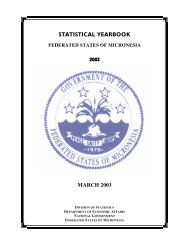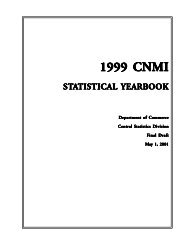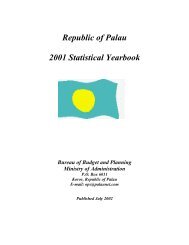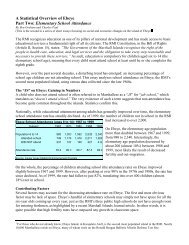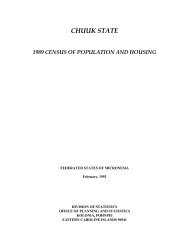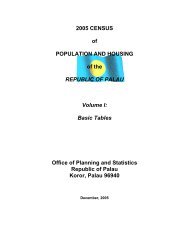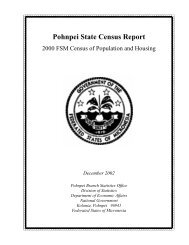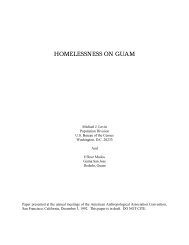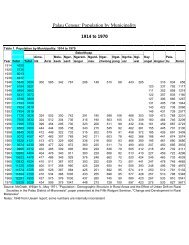Chapter 10. Industry and Occupation2000 FSM <strong>Census</strong> of <strong>Chuuk</strong> <strong>State</strong>Table 10.7: Occupation by Age Groups for Aged 15 years and Over, <strong>Chuuk</strong> <strong>State</strong>: 1994 and 20001994 2000Occupation Total Percent 15-24 25-34 35-44 45-64 65+ Total Percent 15-24 25-34 35-44 45-64 65+Current formal workforce 15+ years 5,373 100.0 11.0 25.8 35.6 26.1 1.4 4,546 100.0 8.5 25.2 31.9 33.3 1.1Executive and managers 393 100.0 4.6 15.8 43.3 33.8 2.5 453 100.0 2.2 12.4 34.7 47.9 2.9Professionals 778 100.0 5.4 20.4 35.5 36.9 1.8 1,165 100.0 4.4 17.7 33.0 43.4 1.5Technical & associate professionals 1,046 100.0 4.7 21.4 41.9 31.1 1.0 575 100.0 5.2 25.6 30.6 37.7 0.9Administrative support 829 100.0 21.8 31.7 32.9 12.3 1.2 523 100.0 18.2 35.4 28.5 17.8 0.2Service workers 868 100.0 11.2 29.4 31.9 26.2 1.4 776 100.0 11.6 32.1 33.0 23.1 0.3Agric. and fishing workers 161 100.0 14.9 32.3 36.6 14.9 1.2 49 100.0 8.2 36.7 26.5 24.5 4.1Craft and related workers 444 100.0 8.1 27.0 38.1 26.4 0.5 304 100.0 9.5 25.3 31.6 33.6 -Machine operators 314 100.0 17.8 27.7 30.9 22.3 1.3 289 100.0 10.7 32.2 34.9 21.5 0.7Elementary occupations & laborers 539 100.0 16.5 30.4 28.8 22.3 2.0 412 100.0 11.4 27.9 28.9 30.3 1.5Armed Forces 1 100.0 - - 100.0 - - - - - - - - -Source: 1994 FSM <strong>Census</strong>, Table P45; 2000 FSM <strong>Census</strong>, Table P3-14Table 10.8 is on the distribution of occupations by age group in 1994 and 2000, and is the type of statistical data, whichraise questions more than present answers. In both census years the four most populous occupations were, not in anyparticular order, professionals, technical and associate professionals, administrative support, and service workers – 65.6percent of all occupations reported in 1994, and 66.8 percent in 2000. For instance, in the age group 15-24 years,administrative support was the largest plurality (30.6 percent in 1994, and 24.5 percent in 2000). In the age group 25-34 years, administrative support and service workers were the plurality (37.4 percent) in 1994, and service workers andprofessionals were the plurality (39.7 percent) in 2000.The one major difference between 1994 and 2000 was found among those 65+ years. In 1994, the two occupationswith the largest plurality were professionals and elementary occupations and laborers (combined 33.4percent). In 2000,the two occupations with majority were executive and managers and professionals (62.5percent)Table 10.8: Occupation for Aged 15 Years and Over by Age Group, <strong>Chuuk</strong> <strong>State</strong>: 1994 and 20001994 2000Age groupsAge groupsOccupation Total 15-24 25-34 35-44 45-64 65+ Total 15-24 25-34 35-44 45-64 65+Current formal workforce15+ years 5,373 592 1,386 1,915 1,405 75 4,546 387 1,146 1,452 1,513 48Percent 100.0 100.0 100.0 100.0 100.0 100.0 100.0 100.0 100.0 100.0 100.0 100.0Executive and managers 7.3 3.0 4.5 8.9 9.5 13.3 10.0 2.6 4.9 10.8 14.3 27.1Professionals 14.5 7.1 11.5 14.4 20.4 18.7 25.6 13.2 18.0 26.5 33.4 35.4Technical and associate professionals 19.5 8.3 16.2 22.9 23.1 13.3 12.6 7.8 12.8 12.1 14.3 10.4Administrative support 15.4 30.6 19.0 14.3 7.3 13.3 11.5 24.5 16.1 10.3 6.1 2.1Service workers 16.2 16.4 18.4 14.5 16.2 16.0 17.1 23.3 21.7 17.6 11.8 4.2Agric. and fishing workers 3.0 4.1 3.8 3.1 1.7 2.7 1.1 1.0 1.6 0.9 0.8 4.2Craft and related workers 8.3 6.1 8.7 8.8 8.3 2.7 6.7 7.5 6.7 6.6 6.7 -Machine operators 5.8 9.5 6.3 5.1 5.0 5.3 6.4 8.0 8.1 7.0 4.1 4.2Elementary occupations and laborers 10.0 15.0 11.8 8.1 8.5 14.7 9.1 12.1 10.0 8.2 8.3 12.5Armed Forces - - 0.1 0.1 - - - - - - - -Source: 1994 FSM <strong>Census</strong>, Table P45; 2000 FSM <strong>Census</strong>, Table P3-14Occupations varied between persons born in <strong>Chuuk</strong> <strong>State</strong> and those born elsewhere. Table 10.9 presents thebreakdown of these two groups by occupation. In 1994, three occupations comprised the minimum majority (50.0percent) for <strong>Chuuk</strong>-born workers – service workers (17.7 percent), technical and associate professionals (16.4 percent),and administrative support (15.9 percent). Two occupations comprised the minimum majority (52.2 percent) forforeign-born workers – technical and associate professionals (35.7percent), and agriculture and fishing workers (16.5percent). The high proportion of foreign-born in agriculture and fishing was due overwhelmingly to the fact that TingHong fishing company was operating in <strong>Chuuk</strong> at that time.In 2000, three occupations comprised the minimum majority (55.2 percent) for <strong>Chuuk</strong>-born workers – professionals25.4 percent), service workers (17.5 percent), and technical and associate professionals (12.3 percent). Twooccupations comprised the minimum majority (55.0 percent) for foreign-born workers – professionals (32.9 percent)and technical and associate professionals (22.1 percent).96 <strong>Chuuk</strong> Branch Statistics Office, Division of Statistics, FSM Department of Economic Affairs
2000 FSM <strong>Census</strong> of <strong>Chuuk</strong> <strong>State</strong>Chapter 10. Industry and OccupationTable 10.9: Occupation for Aged 15 Years and Over by Place of Birth, <strong>Chuuk</strong> <strong>State</strong>: 1994 and 20001994 2000<strong>Chuuk</strong>-born Foreign born <strong>Chuuk</strong>-born Foreign bornOccupation Number Percent Number Percent Number Percent Number PercentCurrent formal workforce 15+ years 4,973 100.0 401 100.0 4,397 100.0 149 100.0Executive and managers 368 6.3 25 6.2 447 10.2 6 4.0Professionals 713 13.5 65 16.2 1,116 25.4 49 32.9Technical and associate professionals 903 16.4 143 35.7 542 12.3 33 22.1Administrative support 813 15.9 16 4.0 511 11.6 12 8.1Service workers 857 17.7 11 2.7 771 17.5 5 3.4Agric. and fishing workers 95 4.6 66 16.5 48 1.1 1 0.7Craft and related workers 420 8.5 24 6.0 284 6.5 20 13.4Machine operators 276 5.5 38 9.5 269 6.1 20 13.4Elementary occupations and laborers 526 11.6 13 3.2 409 9.3 3 2.0Source: 1994 FSM <strong>Census</strong>, Table P79; 2000 FSM <strong>Census</strong>, Table P5-15Table 10.10 further examines occupations by region in 1994 and 2000. Between these two census years the twooccupations with the largest increases in proportionate share among all occupations for persons 15 years and olderwere professionals (14.5 percent in 1994 up to 25.6 percent in 2000) and executive and managers (7.3 percent in1994 now up to 10.0 percent in 2000). Moreover, in 1994, four occupations comprised the minimum majority (65.4percent) of all occupations – technical and associate professionals (19.5 percent), service workers (16.2 percent),administrative support (15.4 percent), and professionals (14.5 percent). In 2000, four occupations comprised theminimum majority (66.8 percent) of all occupations – professionals (25.6 percent), service workers (17.1 percent),technical and associate professionals (12.6 percent) and administrative support (11.5 percent).Regional comparisons in 1994 were not as varied as in 2000. In 1994, both Northern Namoneas and SouthernNamoneas had minimum majorities in the same occupations – technical and associate professionals, administrativesupport, and service workers – 48.7 percent and 55.8 percent, respectively. Faichuk, Mortlocks, and Oksoritod sharedthe same three occupations with minimum majorities – professionals, technical and associate professionals, and serviceworkers – 69.8 percent, 59.4 percent, and 73.5 percent, respectively. In 2000, on the other hand, minimum majoritieschanged in all five regions: Northern and Southern Namoneas with professionals, administrative support, and serviceworkers - 48.0 percent and 56.7 percent, respectively. Faichuk and Mortlocks with professionals, service workers andexecutive and managers 72.0 percent and 63.4 percent, respectively; and Oksoritod with professionals, executives andmanagers, and service workers (83.2 percent).Of course, from 1994 to 2000, there was one consistency – the fact that Northern Namoneas was the locus of mostoccupations – 57.1 percent of the 5,373 occupations in 1994, and 48.5 percent of the 4,546 occupations in 2000.Conversely, Oksoritod had the lowest percentages of occupations – 4.8 percent in 1994, and 6.9 percent in 2000.Table 10.10: Occupation for Aged 15 Years and Over by Region, <strong>Chuuk</strong> <strong>State</strong>: 1994 and 20001994 2000N. NamoneaneasS. Namo-Oksoritod N. Namo-S. Namo-OccupationTotalFaichuk MortlocksTotal neas neas Faichuk Mortlocks OksoritodCurrent formal workforce 15+ yrs 5,373 3,067 861 613 576 257 4,546 2,204 739 607 681 315Percent 100.0 100.0 100.0 100.0 100.0 100.0 100.0 100.0 100.0 100.0 100.0 100.0Executive and managers 7.3 8.4 5.2 3.8 8.2 8.2 10.0 7.3 6.6 7.6 14.8 30.8Professionals 14.5 11.3 12.6 18.9 21.4 33.1 25.6 18.5 25.8 43.3 28.9 34.0Technical and associate19.5 18.0 18.6 26.9 17.5 26.8 12.6 13.1 13.8 8.7 14.4 10.5professionalsAdministrative support 15.4 18.8 13.7 8.2 11.8 6.2 11.5 15.7 10.3 6.4 8.2 2.2Service workers 16.2 11.9 23.5 24.0 20.5 13.6 17.1 13.8 20.6 21.1 19.7 18.4Agric. and fishing workers 3.0 3.7 1.7 3.4 1.4 1.6 1.1 0.8 2.3 1.2 0.9 0.6Craft and related workers 8.3 9.7 9.3 4.2 5.2 3.9 6.7 9.1 9.2 4.1 1.5 0.3Machine operators 5.8 6.9 7.9 2.0 3.1 1.6 6.4 9.8 4.1 1.6 4.4 0.6Elementary occupations & laborers 10.0 11.3 7.3 8.6 10.9 5.1 9.1 12.0 7.3 5.9 7.2 2.5Source: 1994 FSM <strong>Census</strong>, Table P28; 2000 FSM <strong>Census</strong>, Table P2-16Table 10.11 shows how educational attainment of the current formal work force aged 25 years and older, by sex,impacts on occupation. In 2000, males and females did not vary significantly from the total finding – among 3,982reported 42.1 percent had attained only below high school graduates, 49.8 percent were high school graduates andsome college, and 8.2 percent attained bachelor’s degrees and higher. By occupation, those with less than high schoolgraduation dominated two occupations – machine operator and laborer (77.8 percent) and service workers (72.2percent). Those with high school graduation and some college dominated professionals (70.3 percent) and technical,sales, and administrative support (64.2 percent). Persons with at least a bachelor’s degree or higher dominated the<strong>Chuuk</strong> Branch Statistics Office, Division of Statistics, FSM Department of Economic Affairs 97
- Page 5:
iii
- Page 12 and 13:
Preface2000 FSM Census of Chuukx
- Page 14 and 15:
Table of contents2000 FSM Census of
- Page 16 and 17:
LIST OF TEXT TABLESTABLEPageChapter
- Page 18 and 19:
List of Text Table2000 FSM Census o
- Page 20 and 21:
LIST OF FIGURESFIGUREPageFigure 1.1
- Page 22 and 23:
List of Basic-Tables2000 FSM Census
- Page 24 and 25:
MAP OF FSMxxiiChuuk Branch Statisti
- Page 27 and 28:
2000 FSM Census of Chuuk StateExecu
- Page 29 and 30:
CHAPTER 1INTRODUCTIONThe creation o
- Page 31 and 32:
2000 FSM Census of Chuuk StateChapt
- Page 33 and 34:
2000 FSM Census of Chuuk StateChapt
- Page 35 and 36:
2000 FSM Census of Chuuk StateChapt
- Page 37 and 38:
2000 FSM Census of Chuuk StateChapt
- Page 39 and 40:
2000 FSM Census of Chuuk StateChapt
- Page 41 and 42:
2000 FSM Census of Chuuk StateChapt
- Page 43 and 44:
2000 FSM Census of Chuuk State Chap
- Page 45:
2000 FSM Census of Chuuk StateChapt
- Page 48 and 49:
Chapter 2. Age and Sex Structure200
- Page 50 and 51:
Chapter 2. Age and Sex Structure200
- Page 52 and 53:
Chapter 2. Age and Sex Structure200
- Page 55 and 56:
CHAPTER 3HOUSEHOLDS, FAMILIES, AND
- Page 57 and 58:
2000 FSM Census of Chuuk StateChapt
- Page 59 and 60:
2000 FSM Census of Chuuk StateChapt
- Page 61:
2000 FSM Census of Chuuk StateChapt
- Page 64 and 65:
Chapter 4. Fertility2000 FSM Census
- Page 66 and 67:
Chapter 4. Fertility2000 FSM Census
- Page 68 and 69:
Chapter 4. Fertility2000 FSM Census
- Page 71 and 72:
CHAPTER 5MORTALITYIntroductionAs re
- Page 73 and 74: 2000 FSM Census of Chuuk StateChapt
- Page 75: 2000 FSM Census of Chuuk StateChapt
- Page 78 and 79: Chapter 6. Migration2000 FSM Census
- Page 80 and 81: Chapter 6. Migration2000 FSM Census
- Page 82 and 83: Chapter 6. Migration2000 FSM Census
- Page 84 and 85: Chapter 6. Migration2000 FSM Census
- Page 86 and 87: Chapter 7. Religion, Ethnicity, and
- Page 88 and 89: Chapter 7. Religion, Ethnicity, and
- Page 90 and 91: Chapter 7. Religion, Ethnicity, and
- Page 92 and 93: Chapter 8. Education2000 FSM Census
- Page 94 and 95: Chapter 8. Education2000 FSM Census
- Page 96 and 97: Chapter 8. Education2000 FSM Census
- Page 98 and 99: Chapter 8. Education2000 FSM Census
- Page 100 and 101: Chapter 8. Education2000 FSM Census
- Page 103 and 104: CHAPTER 9ECONOMIC ACTIVITYIntroduct
- Page 105 and 106: 2000 FSM Census of Chuuk StateChapt
- Page 107 and 108: 2000 FSM Census of Chuuk StateChapt
- Page 109 and 110: 2000 FSM Census of Chuuk StateChapt
- Page 111 and 112: 2000 FSM Census of Chuuk StateChapt
- Page 113 and 114: 2000 FSM Census of Chuuk StateChapt
- Page 115 and 116: 2000 FSM Census of Chuuk StateChapt
- Page 117 and 118: CHAPTER 10INDUSTRY AND OCCUPATIONIn
- Page 119 and 120: 2000 FSM Census of Chuuk StateChapt
- Page 121 and 122: 2000 FSM Census of Chuuk StateChapt
- Page 123: 2000 FSM Census of Chuuk StateChapt
- Page 127 and 128: 2000 FSM Census of Chuuk StateChapt
- Page 129 and 130: CHAPTER 11INCOMEIntroductionThe 200
- Page 131 and 132: 2000 FSM Census of Chuuk StateChapt
- Page 133 and 134: 2000 FSM Census of Chuuk StateChapt
- Page 135 and 136: 2000 FSM Census of Chuuk StateChapt
- Page 137: 2000 FSM Census of Chuuk StateChapt
- Page 140 and 141: Chapter 12. Housing2000 FSM Census
- Page 142 and 143: Chapter 12. Housing2000 FSM Census
- Page 144 and 145: Chapter 12. Housing2000 FSM Census
- Page 146 and 147: Chapter 12. Housing2000 FSM Census
- Page 148 and 149: Chapter 12. Housing2000 FSM Census
- Page 150 and 151: Chapter 12. Housing2000 FSM Census
- Page 152 and 153: Chapter 12. Housing2000 FSM Census
- Page 154: Chapter 12. Housing2000 FSM Census
- Page 157 and 158: BIBLIOGRAPHYArriaga, E.E., (1983).
- Page 159: 2000 FSM Census of Chuuk StateBibli
- Page 162 and 163: Basic Tables2000 FSM Census of Chuu
- Page 164 and 165: Basic Tables2000 FSM Census of Chuu
- Page 166 and 167: Basic Tables2000 FSM Census of Chuu
- Page 168 and 169: Basic Tables2000 FSM Census of Chuu
- Page 170 and 171: Basic Tables2000 FSM Census of Chuu
- Page 172 and 173: Basic Tables2000 FSM Census of Chuu
- Page 174 and 175:
Basic Tables2000 FSM Census of Chuu
- Page 176 and 177:
Basic Tables2000 FSM Census of Chuu
- Page 178 and 179:
Basic Tables2000 FSM Census of Chuu
- Page 180 and 181:
Basic Tables2000 FSM Census of Chuu
- Page 182 and 183:
Basic Tables2000 FSM Census of Chuu
- Page 184 and 185:
Basic Tables2000 FSM Census of Chuu
- Page 186 and 187:
Basic Tables2000 FSM Census of Chuu
- Page 188 and 189:
Basic Tables2000 FSM Census of Chuu
- Page 190 and 191:
Basic Tables2000 FSM Census of Chuu
- Page 192 and 193:
Basic Tables2000 FSM Census of Chuu
- Page 194 and 195:
Basic Tables2000 FSM Census of Chuu
- Page 196 and 197:
Basic Tables2000 FSM Census of Chuu
- Page 198 and 199:
Basic Tables2000 FSM Census of Chuu
- Page 200 and 201:
Basic Tables2000 FSM Census of Chuu
- Page 202 and 203:
Basic Tables2000 FSM Census of Chuu
- Page 204 and 205:
Basic Tables2000 FSM Census of Chuu
- Page 206 and 207:
Basic Tables2000 FSM Census of Chuu
- Page 208 and 209:
Basic Tables2000 FSM Census of Chuu
- Page 210 and 211:
Basic Tables2000 FSM Census of Chuu
- Page 212 and 213:
Basic Tables2000 FSM Census of Chuu
- Page 214 and 215:
Basic Tables2000 FSM Census of Chuu
- Page 216 and 217:
Basic Tables2000 FSM Census of Chuu
- Page 218 and 219:
Basic Tables2000 FSM Census of Chuu
- Page 220 and 221:
Basic Tables2000 FSM Census of Chuu
- Page 222 and 223:
Basic Tables2000 FSM Census of Chuu
- Page 224 and 225:
Basic Tables2000 FSM Census of Chuu
- Page 226 and 227:
Basic Tables2000 FSM Census of Chuu
- Page 228 and 229:
Basic Tables2000 FSM Census of Chuu
- Page 230 and 231:
Basic Tables2000 FSM Census of Chuu
- Page 232 and 233:
Basic Tables2000 FSM Census of Chuu
- Page 234 and 235:
Basic Tables2000 FSM Census of Chuu
- Page 236 and 237:
Basic Tables2000 FSM Census of Chuu
- Page 238 and 239:
Basic Tables2000 FSM Census of Chuu
- Page 240 and 241:
Basic Tables2000 FSM Census of Chuu
- Page 242 and 243:
Basic Tables2000 FSM Census of Chuu
- Page 244 and 245:
Basic Tables2000 FSM Census of Chuu
- Page 246 and 247:
Basic Tables2000 FSM Census of Chuu
- Page 248 and 249:
Basic Tables2000 FSM Census of Chuu
- Page 250 and 251:
Basic Tables2000 FSM Census of Chuu
- Page 252 and 253:
Basic Tables2000 FSM Census of Chuu
- Page 254 and 255:
Basic Tables2000 FSM Census of Chuu
- Page 256 and 257:
Basic Tables2000 FSM Census of Chuu
- Page 258 and 259:
Basic Tables2000 FSM Census of Chuu
- Page 260 and 261:
Basic Tables2000 FSM Census of Chuu
- Page 262 and 263:
Basic Tables2000 FSM Census of Chuu
- Page 264 and 265:
Basic Tables2000 FSM Census of Chuu
- Page 266 and 267:
Basic Tables2000 FSM Census of Chuu
- Page 268 and 269:
Basic Tables2000 FSM Census of Chuu
- Page 270 and 271:
Basic Tables2000 FSM Census of Chuu
- Page 272 and 273:
Basic Tables2000 FSM Census of Chuu
- Page 274 and 275:
Basic Tables2000 FSM Census of Chuu
- Page 276 and 277:
Basic Tables2000 FSM Census of Chuu
- Page 278 and 279:
Basic Tables2000 FSM Census of Chuu
- Page 280 and 281:
Basic Tables2000 FSM Census of Chuu
- Page 282 and 283:
Basic Tables2000 FSM Census of Chuu
- Page 284 and 285:
Basic Tables2000 FSM Census of Chuu
- Page 286 and 287:
Basic Tables2000 FSM Census of Chuu
- Page 288 and 289:
Basic Tables2000 FSM Census of Chuu
- Page 290 and 291:
Basic Tables2000 FSM Census of Chuu
- Page 292 and 293:
Questionnaire2000 FSM Census of Chu
- Page 294 and 295:
Questionnaire2000 FSM Census of Chu
- Page 296 and 297:
Questionnaire2000 FSM Census of Chu



